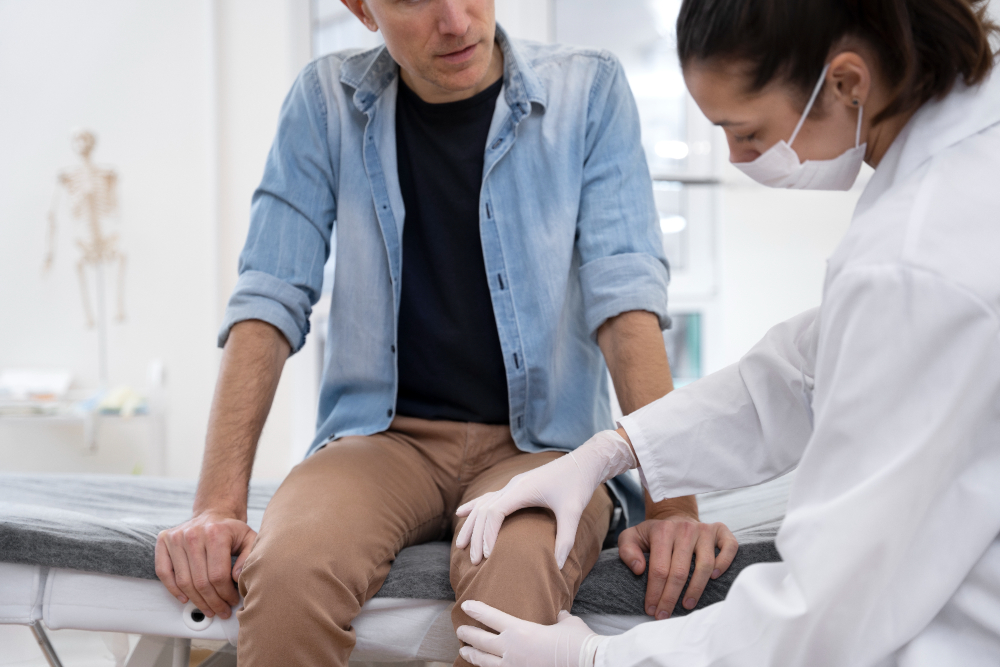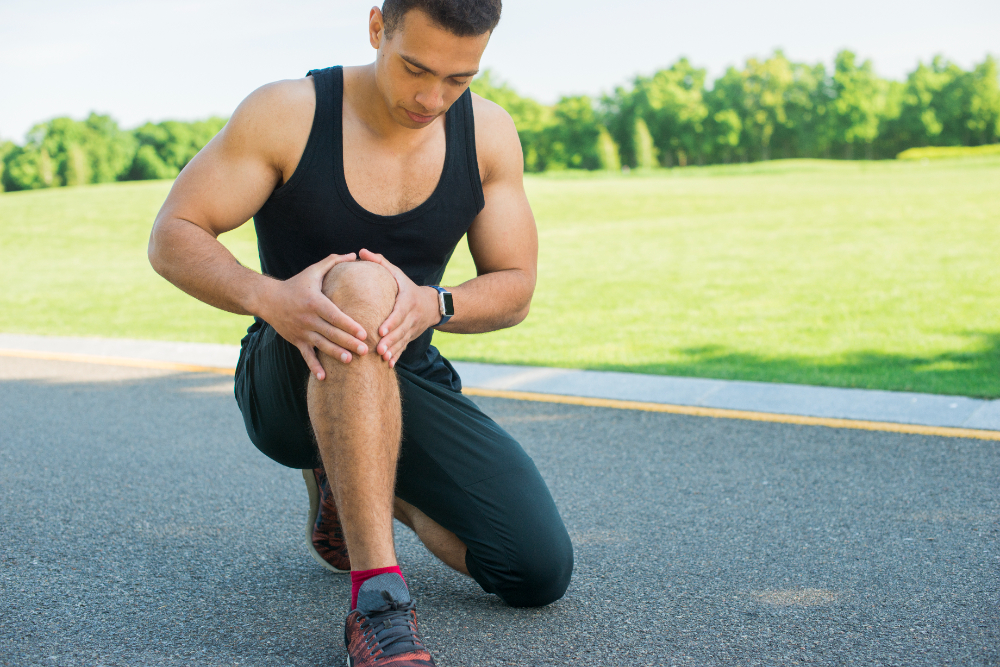Knee Specialist Services in Singapore


As the largest joint in the body, the knee’s complex structure allows for intricate movements but also puts it at risk of various types of injuries. Therefore, consulting a knee pain specialist in Singapore is crucial for accurate diagnosis and effective treatment. Conditions like ligament tears, meniscus injuries, and osteoarthritis often require expert evaluation to determine the best course of action, which may include non-surgical options like medication and physical therapy or surgical interventions.
This ensures you receive the most appropriate treatment to address your specific condition and restore knee function.
When to See a Knee Pain Specialist
While it’s important to listen to your body and seek medical advice for any persistent discomfort, some knee symptoms warrant prompt evaluation by a knee specialist. These include:
Persistent pain:
Pain lasting more than two weeks despite home care, especially pain that worsens with prolonged walking, standing, or getting up after sitting for a while.
Swelling and inflammation:
Noticeable swelling, redness, or warmth around the knee, possibly after hearing a popping sound.
Limited mobility:
Difficulty bending, straightening, or bearing weight on the knee.
Instability: Feeling like your knee might “give way” or buckle.
Activity-related pain:
Pain that increases with activities like climbing stairs or running.
Mechanical symptoms:
Locking, catching, or clicking sensations in the knee joint or feeling something moving inside the knee.

Common Knee Conditions We Treat
Osteoarthritis of the Knee
Osteoarthritis is a common condition where the cartilage that cushions the knee joint wears down, causing pain, stiffness, and swelling. This can make everyday activities like walking and climbing stairs difficult.
Ligament Injuries
Ligaments are strong bands of tissue that connect bones in the knee. Sudden twisting or impact can injure these ligaments, such as the anterior cruciate ligament (ACL), posterior cruciate ligament (PCL), medial collateral ligament (MCL), and lateral collateral ligament (LCL). These injuries can lead to pain, instability, and a feeling of the knee giving way.
Meniscus Tears
The meniscus is a C-shaped piece of rubbery cartilage that acts as a shock absorber in the knee. Each knee has two menisci, the medial meniscus and the lateral meniscus. Tears often happen during twisting movements, causing pain, clicking, and limited knee movement.
Cartilage Tears
Cartilage is the layer of soft bone that lines the hard bone in the knee joint. This allows the shin bone to move against the thigh bone in a smooth manner. Cartilage tears may give rise to pain during activity, such as going up or going own stairs, swelling or a locking sensation.
Patellar Tendinitis (Jumper’s Knee)
This overuse injury causes pain and inflammation in the tendon that connects the kneecap to the shinbone. It’s common in activities involving repetitive jumping, like basketball or volleyball.
Runner’s Knee (Patellofemoral Pain Syndrome)
This condition causes pain at the front of the kneecap, often due to overuse, misalignment, or weak thigh muscles. It’s common in runners and those who participate in activities that put repetitive stress on the knee.
Ilio-Tibial Band (ITB) Syndrome
ITB Syndrome refers to a pain that occurs on the outside of the knee, along the ITB. This happens frequently in runners.
Patellar Mal-Alignment Issues
The patella refers to the kneecap bone at the front of the knee. Mal-alignment issues may involve excessive laxity of the patella or excessive tightness of the patella. Such issues cause pain during activity, climbing stairs, or if more serious, pain when walking on flat ground.
Knee Fractures
A knee fracture is a break in one of the bones that make up the knee joint. These fractures often require surgical treatment to ensure proper healing and restore knee function.
Baker’s Cyst
A Baker’s cyst is a fluid-filled swelling at the back of the knee that commonly arises due to degenerative changes or Osteoarthritis in the knee. It may cause tightness and discomfort at the back of the knee.

Diagnosis of Knee Pain
Accurate diagnosis is crucial for effective treatment. To determine the cause of your knee pain, your doctor may use a combination of the following:
Physical Examination:
A thorough examination to assess your knee’s range of motion, stability, and any signs of injury.
X-rays:
To visualise the bones and identify fractures, alignment issues, or signs of arthritis.
MRI (Magnetic Resonance Imaging):
To create detailed images of soft tissues, such as ligaments, tendons, and cartilage, helping to identify tears or other damage.
CT Scans:
For a more detailed view of bone structures, particularly helpful in complex fractures.
Ultrasound:
To visualise soft tissues and assess fluid buildup or inflammation in real time.
Non-Surgical Knee Pain Treatments
When appropriate, your knee pain specialist may recommend non-surgical approaches to manage your knee pain and improve function. These may include:
Physiotherapy:
A personalised exercise programme to strengthen muscles around the knee, improve flexibility, and restore joint stability.
Medications:
Pain relievers and anti-inflammatory drugs can help manage pain and reduce swelling.
Steroid Injections:
These injections can help reduce inflammation and provide temporary pain relief for conditions like arthritis or tendonitis. other damage.
Hyaluronic Acid Injections:
These injections can improve lubrication and cushioning within the joint, often used for osteoarthritis.
Biological Tissue-healing Injections:
These injections are used particularly for ligamentous and muscle conditions and help stimulate the body to form some new tissue for healing.
Marrow Injections:
This involves taking the patients’ own liquid bone marrow and injecting it into the knee, thereby stimulating the body to stabilise damaged cartilage.
Bracing and Supports:
Braces or supports can help stabilise the knee, reduce strain, and protect it from further injury.
Lifestyle Modifications:
Losing weight, adjusting activity levels, and making ergonomic changes can help reduce stress on the knee joint.
Advanced Surgical Solutions
While non-surgical options are often the first line of treatment, some knee conditions may require surgical intervention to restore function and relieve pain. Here are some of the advanced surgical procedures offered:
- Arthroscopic Surgery (Keyhole Surgery): This minimally invasive technique uses small incisions and specialised instruments to diagnose and treat various knee conditions, such as ligament tears, meniscus repairs and cartilage repairs.
- ACL Reconstruction Surgery: This procedure reconstructs a torn anterior cruciate ligament (ACL) using a graft from your own body or a donor.
- Partial Knee Replacement Surgery: In cases where arthritis affects only one part of the knee, a partial knee replacement can resurface the damaged area while preserving healthy bone and tissue.
- Total Knee Replacement Surgery: This procedure replaces the damaged surfaces of the knee joint with artificial components to relieve pain and restore mobility in cases of severe arthritis or injury.
- Knee Cartilage Surgery and Restoration Procedures: These techniques, including surgical options, aim to repair or regenerate damaged cartilage, helping to preserve knee function and potentially delay the progression of arthritis.
- Fracture Fixation Surgery: This involves stabilising broken bones in the knee with plates, screws, or rods to ensure proper healing and alignment.
Recovery and Rehabilitation for Knee Pain
Recovery from knee pain, whether treated surgically or non-surgically, involves a dedicated rehabilitation process. This is essential to regain strength and mobility and return to your desired activity levels.
Physiotherapy:
A personalised physiotherapy programme will help you regain strength, flexibility, and range of motion in your knee. Your physiotherapist will guide you through exercises and techniques tailored to your specific needs and recovery goals.
Recovery Timelines:
Recovery time varies depending on the exact condition and the type of treatment you receive. Your doctor will provide a personalised timeline based on your condition and treatment plan.
Return to Activity:
It’s important to only gradually increase your activity levels as your knee heals. Your doctor and physiotherapist will guide you on safely returning to your normal activities, including sports and exercise.

Preventing Knee Pain and Injuries
Taking proactive steps to maintain knee health can help reduce your risk of pain and injury. Here are some tips:
Stay Active:
Engage in regular low-impact exercises like swimming, cycling, or walking to keep your knee joints mobile and strengthen supporting muscles.
Build Strength:
Focus on strengthening exercises for your quadriceps (front of thigh) and hamstrings (back of thigh) to provide better support for your knee joint.
Choose Proper Footwear:
Wear supportive shoes with good cushioning to absorb shock and reduce stress on your knees.
Increase Activity Gradually:
Avoid sudden increases in exercise intensity or duration, which can overload your knee joints.
Maintain a Healthy Weight:
Excess weight puts extra strain on your knees. Maintaining a healthy weight can significantly reduce your risk of knee pain and osteoarthritis.
Warm Up Before Activity:
Always warm up your muscles before exercise or strenuous activity to prepare your knees for the load.
Use Proper Technique:
Use proper form and technique during exercise and daily activities to avoid unnecessary stress on your knees.
Listen to Your Body:
Pay attention to pain signals and rest when needed. Don’t push yourself beyond your limits.
Choosing the Right Knee Pain Specialist
Finding the right knee specialist can make a significant difference in your treatment and pain recovery. Here are some key factors to consider:
Experience and Expertise:
Look for a specialist with extensive experience in treating a wide range of knee conditions, including your specific concerns. Consider their expertise in both non-surgical and surgical treatments.
Advanced Techniques:
Choose a specialist who utilises the latest advancements in knee care, including minimally invasive surgical techniques and innovative treatment options.
Comprehensive Care:
Seek an orthopaedic clinic in Singapore that offers a comprehensive approach to knee care, including access to advanced diagnostic tools, physiotherapy, and personalised rehabilitation programmes.
Patient-Centric Approach:
Choose a specialist or doctor who prioritises patient-centred care, listens to your concerns, and develops a treatment plan tailored to your individual needs and goals.
If you’re experiencing knee pain, schedule a consultation with us today to discuss your individual needs and learn more about how our experienced specialists can help you regain your mobility and quality of life.
Frequently Asked Questions About Knee Pain Treatment
Can knee pain be treated without surgery?
Yes, many cases of knee pain can be effectively managed with non-surgical treatments like physiotherapy, medications, injections, bracing, and lifestyle modifications. Surgery is typically considered when non-surgical options have been exhausted or if the condition is severe.
What are the most common causes of knee pain?
Knee pain can arise from various factors, including injuries such as ligament tears, meniscus tears, tendonitis, and fractures. Medical conditions like osteoarthritis, rheumatoid arthritis, and gout can also cause knee pain. Overuse from repetitive strain, such as running or jumping, can lead to knee problems. Additionally, the natural ageing process can cause wear and tear on the joint, contributing to pain and stiffness.
How long does recovery take after knee surgery?
Recovery time varies depending on the type of surgery, individual factors, and adherence to rehabilitation. Generally, it takes several weeks to months to regain full mobility and function. Your surgeon will provide a personalised recovery plan and timeline.
What is the cost of knee pain treatment in Singapore?
The cost of knee pain treatment varies depending on the type of treatment, the severity of the condition, and the clinic you choose. It’s best to schedule a consultation with us to discuss your specific needs and get a personalised quote.
Is knee surgery covered by Medisave or insurance?
Procedures or surgeries carried out in hospitals are generally covered under Hospitalisation insurance plans and Medisave. At Centurion, we have extensive experience assisting our patients in verifying their coverage and securing the required pre-authorisations or Letters of Guarantee prior to commencing treatment.

Services
Medisave / Insurances
Treatments
Ankle Sprain & Treatment
Cartilage Repair Treatment
Bone Fracture Treatment
Alternatives to Knee Replacement
Knee Replacement Surgery
ACL Reconstruction Surgery
Knee Cartilage/Meniscus Tear Injury
Heel Spur Treatment
Hip Replacement Surgery
Hip Scope Surgery
Shoulder Scope Surgery
Ankle Ligament Surgery
Spinal Injection Therapy
Steroid Injection
Patient Resources


